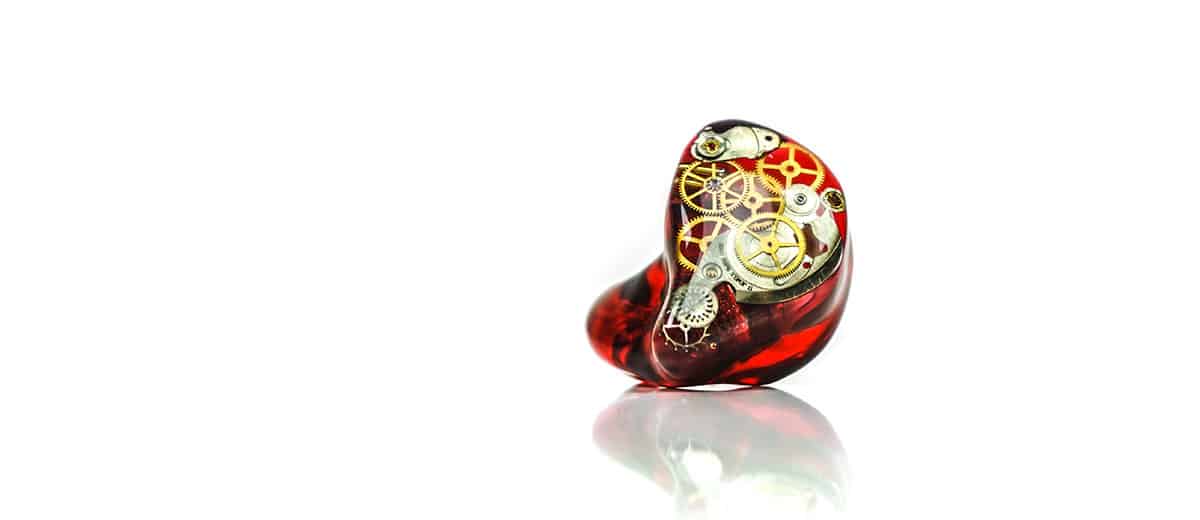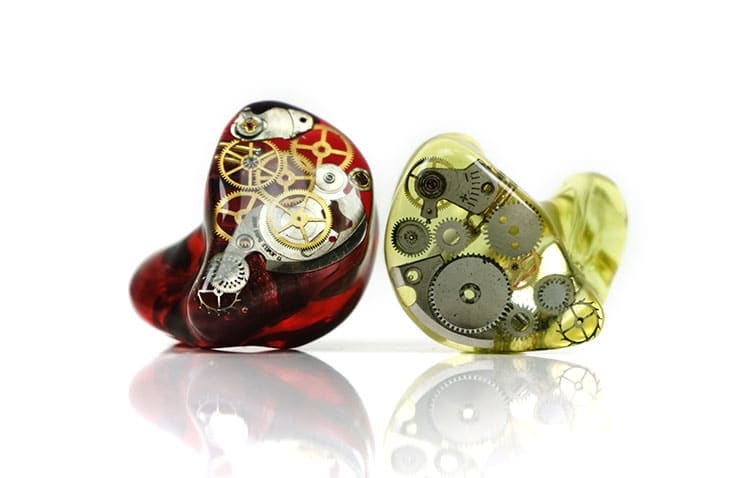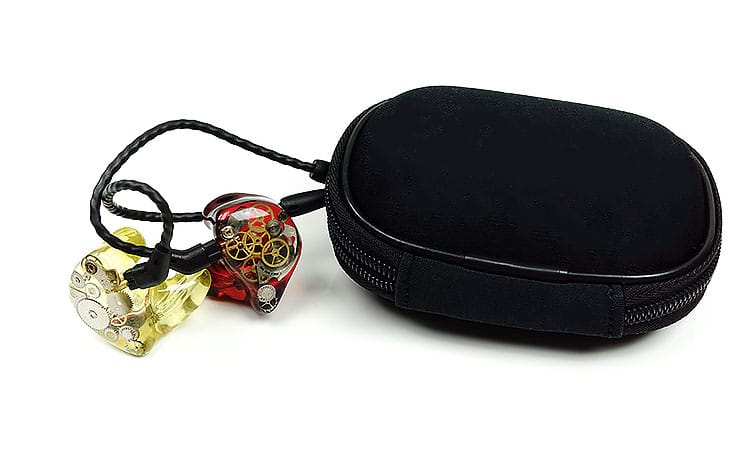Meet the AV3
Design
This AV3 is a mix of everything Avara could throw at us. From the free basic red left shell to the premium yellow 3D-printed right and both of them adorned with their “Ultimate” category watch clock faceplates. We wanted to see what they could do creatively and to be frank I never had a watch clock CIEM before so it was a first for me also.
Yes, I know clock faces in customs might be a slightly unoriginal thinking but a well-done clock design can sometimes look the business. Other times they can look anemic and overly simplistic. Not in this case. We requested Avara to make a complex one based on some designs we had seen before and to be fair they were very faithful to the submitted design.
There is a very slight rustic look to the watch components which I tend to prefer over cleaner versions. Overall, a very good design finish with excellent attention to the clockface detail.
The rest of the shell body is a translucent red and yellow left and right combo. The yellow does cost an additional $20 which is not a huge amount but something to be aware of. The red print is one of the free designs.
Finish
From what I have been told there were some ongoing improvements in the final production process for all their IEMs so the earlier ones had possibly a higher bubble count in the acrylic shell fills. However, since then and including this unit the production process has been refined so there should be lower bubble counts.
Whilst it is not 100% bubble-free the count is indeed very low and more than acceptable at this price point. I would have to zoom in with a macro lens to spot any production blemishes on these shells. Under the naked eye and regular lighting conditions, you can’t really see any blemishes at all.
Internals
Knowles CI
Being translucent you can get a very clear idea of the internal design of the AV3. This is a triple driver BA design but the low-end driver is one of the bigger CI series of Knowles drivers which tend to perform very well indeed for low-end response compared to the smaller versions.
In fact, so potent is their potential to drown everything else Avara has tuned the output of the low-end larger driver to be around 6dB lower to retain a good balance with the two smaller mids and high drivers.
Dual Bore
The drivers are in parallel using a dual-bore tube design and situated just above the nozzle. Phase and timing control is done via a 3-way active crossover design which you can see just behind the drivers on a small mounted green PCB. You will not see any elongated high-frequency tube designs ala JH Audio.
The rest of the shell is filled with acrylic to add some additional weight and durability against accidental drops where a hollow body would be more likely to crack. Acrylic filling on non-vented BAs should not present an issue on performance as the sound is delivered directly from the BA to the ear via the dual-bore tube design.
Cable & Connectors
Stock Cable
The AV3 uses a 0.78mm 2-pin connector system in a flush socket on the top of each shell. This is probably the most general of detachable cable designs which is just as well because the cable is just an ‘off the shelf’ copper or OFC 4-wire 1.2m braided-type design in a black PVC jacket.
The cable is terminated with a right angle 3.5mm gold plated TRRS jack, matching y-strain barrels, and an adjustable cinch. It also uses a memory wire system for shaping around the ear and to lower the potential for physical noise traveling up the wire. It is light, pliant, and very quiet but not the best sounding cable.
Aftermarket Cable Conundrum
I have nothing against these cables, to be honest. They do keep costs down and provide a normally warmish or basic copper sound that I would term inoffensive. However, they often lack good dynamic range and are not the last word in detail compared to better aftermarket cables.
My only issue with using an aftermarket cable is that it could end up significantly adding to the cost of the AV3. Considering the AV3 is just $320 and, say an EA Ares II, which is $150, you are talking a 50% markup. The AV3 suddenly becomes less of a value choice.
That being said, outside of Empire Ears, there are not too many companies offering good quality cables with custom designs to begin with. Quite often it is a variant of the very same cable Avara are using on the AV3.
Suggestions
If you do want an aftermarket cable but want a better price there is a fairly competitive variant of the SPC infused 8-wire iBasso CB12 terminated with a 2-pin floating around Penon for $89. It should be enough to clean up the dynamic range a bit more and bring in some additional clarity.
The next up from that is the Ares II from Effect Audio at $150 which is a 4-wire copper Litz design but should provide a cleaner snappier sound with better treble extension than the stock cable.
Comfort & Seal
Avara Customs uses a 3D-Printer which means so long as your ear impression is accurate then so also will be your custom design. That is in theory, nothing is ever perfect but if you trust your audiologist and they have done good ones before then the final production unit should be a perfect fit.
My molds submitted were originally used for the A18 review from 64 Audio so the digital scans are compatible with their printing process. As a result, I got almost the same level of comfort as the A18, which, is a good thing. The seal was also excellent.
Comparison Fittings
I do say almost the same as the A18 because every custom manufacturer has their own interpretation and finish. For one thing, the nozzle is a touch thicker on the AV3 than my A18 with slightly less “shape”.
The main body is a lot deeper with more weight due to the acrylic fill inside the larger AV3 body. The AV3 seal seems to work by putting a bit more ‘nuanced pressure’ to the ear canal walls than the absolutely pinpoint accurate fit such as you find on the 64 Audio units.
Compared to the Custom Art FIBAE 3, which is also a triple-driver, the AV3 is much bigger also. Again, the nozzle is a little deeper and wider than the FIBAE 3 and I do find the AV3 is the better of the two for creating a rock-solid seal.
My hats off to Minerva from the UK though. The Mi-Artist Pro is the deepest of the 4 units compared in terms of nozzle length and the absolute best in isolating or attenuating noise though only by a tiny margin.
Sound Impressions
Summary
The AV3 is a musical or fun sounding presentation with an elevated mid-bass response, a full-bodied lower mid, and a fairly rich and at times lush sounding instrumental timbre. It also delivers a more intimate vocal presence with some good but not overly forward lower treble energy. The high-end starts to roll-off starting around 8k.
I suspect there is a tiny “hi-fi” bump around 11-12k just to prevent it from sounding dark. There is a little bit of air but as such, I would not define this as an overly airy or well-extended top-end.
The AV3 is more forgiving than exacting with a tonality that delivers more on euphony than outright accuracy. Avara has painted the performance as intended for “mainstream” music and to a certain extent that is quite accurate.
They are highly enjoyable and easy to listen to in genres such as synth-wave, EDM, and R’n’B. Where I do crave a little more is on classic rock and metal where I find myself starting to cable swap just to bring in some additional clarity on the lower midrange guitar performances.
Soundstage
Staging is actually very good on the AV3 though right at the very low-end there is a little sub-bass roll-off not untypical of a BA driver bass response.
That is not to say it does not lack staging depth. The CI driver is quite potent in terms of quantity and depth so it is actually very good for a triple BA driver design. Avara has resisted going for a traditional intimate n-shaped intimate signature so it is certainly much more spacious sounding than the older Westone triple driver units such as the UM3x.
Bass
The AV3 low-end is warm and plentiful with moderate levels of impact. The sub-bass response is not quite as physical as a good dynamic driver but it has an excellent mid-bass quantity and a minor dip to around 700-800Hz though nothing overly abrupt.
The majority of its elevation is centered around 80-100Hz and stays fairly plateaued to about 250Hz before dropping slowly.
The CI driver used by Avara is fairly powerful. Speaking with the team they did state that they had to limit the power of the driver a little (up to -6dB) just to make sure it did not end up overpowering the mids and sounding overly bloated.
It does have a slightly longer decay than regular smaller BA drivers so it is a touch slower and maybe a little looser or relaxed in its delivery.
Mids
Avara has tuned the mids on the AV3 with a forward vocal presence and a rich euphonic instrumental timbre that delivers a smooth, almost lush sounding performance.
Lower mids have not been dipped too much and retain a fair degree of warmth from the low-end so texture and note body on the AV3 is actually very good.
Despite the full-bodied approach Avara has managed to keep the AV3 mids relatively open sounding with good instrumental separation. It is not the last word in detail so it is not as accurate as I would like it to be with that softer liquid-like presentation. It does add to the overall forgiving nature of the AV3’s presentation.
Vocals are excellent in terms of tone and texture on the AV3. Particularly with huskier vocalists like Nicks and Buika which are very smooth and full-sounding with next to zero sibilance or edginess.
Elaborate melismatic vocal riffs from the likes of Ellie Goulding’s sweet and wispy vocal pitch are ideally suited to the AV3’s ‘wetter’ delivery.
Treble
The AV3 treble is relaxed overall though the lower treble is further forward sounding up to around 7k before it starts to roll off beyond 8k. There is a slight bump around 11-12k to prevent it from sounding dark and it does help with the staging and headroom of the AV3.
Treble focus is more around 3-7k though by no means strident or uneven sounding. The mids to treble transition is actually very coherent. Higher-pitched percussion does have a nice level of body and a fairly natural timbre without being overly snappy and dominating.
Click on Page 3 below for Pairings & Comparisons




